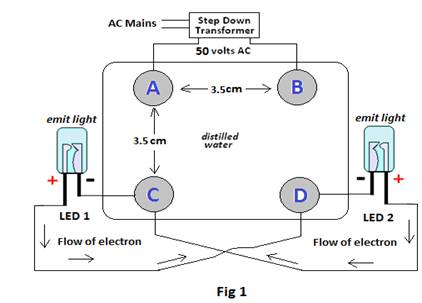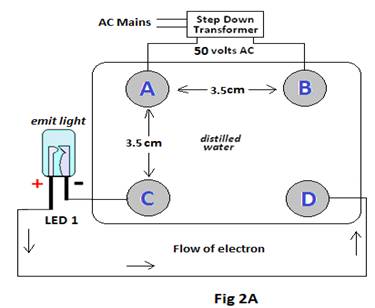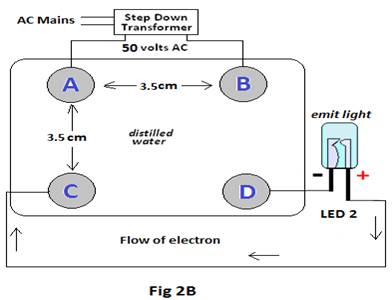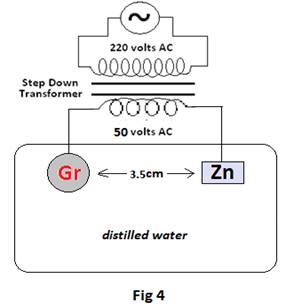Imponderabilia are homeopathic remedies whose source material is intangible such as magnetism, electricity, x-rays and moonlight. The functioning of Imponderabilia is mysterious, since no active molecules are known to take part in their preparation. It has been shown earlier that EMRs are able to induce alternating current in the water of a living body1. It is thus clear that homeopathic Imponderabilia are prepared by utilizing the alternating current induced by Electromagnetic Radiation in the water contained in the alcohol or sugar of milk (lactose monohydrate ).
Though it is already shown how the electrical energy of substances that contain active molecules are conveyed through water2,3 the impact of alternating current on water is yet to be explained. It is already shown that water is able to retain direct current (i.e. current drawn from a cell or battery) through molecular orientations4, but the effect of alternating current on water is particularly interesting as the polarity reverses with time. To explore the impact of passing of alternating current through water we performed the following experiment.
Materials Used: A step down transformer (220 volts AC to 50 volts AC, 500mA), graphite rods, LED’s (low voltage range), glass bowl, meter, Zinc (Zn), Lead (Pb) and distilled water.
Experiment 1: A step down transformer is used to step down 220 volts AC to 50 volts AC. Two terminals of the step down end of the transformer are connected to the GrA & GrB paired electrode and it is placed in a glass bowl containing about 20ml distilled water. Two graphite electrodes, GrC & GrD, are placed in front of GrA & GrB respectively at a distance of about 3.5cm. Now two LEDs (LED1 & LED2) are connected to GrC & GrD with reverse polarity as shown in Fig1. The alternating current is then allowed to pass through GrA & GrB for 3 minutes.
Observations: While passing 50 volts AC (actually about 56 volts AC) through GrA & GrB it is observed that AC emf shown by GrC & GrDr is about 2.2 volts AC but on disconnecting the supply of AC emf, no AC emf is shown by GrC& GrD. But, the DC emf shown by GrC& GrD before and after passing of AC emf for 3 minutes is found to be 37mV and 30 mV respectively.
Discussion: As no AC emf is is shown by the GrC& GrD electrode even after passing of AC through GrA & GrB, it appears that there is no effect from passing 50 volts AC through water i.e. AC fails to effect orientations of water molecules. But the change in DC emf of the electrode GrC& GrD from 37 mV to 30mV, though little, shows definite effect from passing of alternating current through water.
Experiment 2: A step down transformer is used to step down 220 volts AC to 50 volts AC. Two terminals of the step down end of the transformer are connected to GrA & GrB placed in a glass bowl containing about 20ml distilled water. Two graphite electrodes GrC & GrD are placed in front of GrA & GrB respectively at a distance of about 3.5cm. Now in
Case 1: The negative and positive lead of an LED is connected to GrC & GrD respectively, generating positive DC emf i.e. (Fig2A). The alternating current is then allowed to pass through GrA & GrB for 3 minutes. Both the AC emf and the DC emf shown by GrC & GrD are noted before and after passing of AC emf through GrA & GrB and noted as initial & final emf in table below.
Case 2: The experiment is repeated by reversing the polarity of the LED i.e. positive and negative lead of an LED is connected to GrC & GrD respectively generating positive DC emf as shown in (Fig 2B).
The observations are noted in tabular form:
Observations:
| Case No. | AC Emf shown by | DC Emf shown by | |||
| GrC & GrD before passing of AC through GrA & GrB | GrC & GrD after passing of AC through GrA & GrB for 3mins | GrC & GrD before passing of AC through GrA & GrB (initial emf) | GrC & GrD after passing of AC through GrA & GrB for 3mins(final emf) | Differencei.e final -initial(in mV) | |
| Case 1 | 0 V | 0 V | -35mV | 436mV | 471mV |
| Case 2 | 0 V | 0 V | -20mV | -630 mV | -610 mV |
Discussion: Though no effect in AC emf is found for GrC & Gr D after passing of AC emf (i.e. alternating current) through GrA & GrB, considerable change in DC emf is found for GrC & Gr D, which strongly suggests the alteration in molecular arrangement i.e. orientations, of water on passing of Alternating Current. It is also found that the graphite electrode to which the negative lead of the LED is connected behaves as a positive electrode and vice versa . It is due to which DC emf for GrC & Gr D is positive (471mV) in case A while it is negative (-610 mV) in case B. This is due to the fact that an LED only allows a flow of electrons when forward biased and thus allows a flow of electrons from GrC to GrD while emitting light in case A & GrD to GrC in case B. Thus, restriction in flow of electrons from GrD to GrC in case A &GrC to GrD in case B, in turn results in accumulation of excess electrons at Gr Dand GrC to make them act as negative electrode for case A & case B respectively, while generating DC emf.
Experiment 3: Two electrodes Gr & Zn are placed in about 20ml of distilled water. The DC emf of Gr & Zn is recorded as initial emf . The two terminals of the transformer producing 50 volts AC (actually 56 volts AC) are then connected to Gr & Zn and alternating current is allowed to pass for 3 minutes. The initial /final emf of Gr & Zn is recorded in the table 2 below. The experiment is then repeated with Gr-Gr and Gr-Pb.
Observations: The observations are noted in table 2. below:
Table 2
| Electrode+ – | Initial(AC emf in Volts)Before passing of AC emf | Final(AC emf in Volts)After passing of AC emf | Initial(DC emf in mV)Before passing of AC emf | Final(DC emf in mV)After passing of AC emf | Difference(in mV) |
| Gr- Zn | 0 | 0 | 802 | 674 | –126 |
| Gr- Gr | 0 | 0 | -14 | –26 | –12 |
| Gr- Pb | 0 | 0 | 725 | 698 | –27 |
Discussion: For all the three s (i.e. Gr- Zn , Gr- Gr &Gr- Pb ) though there is no change in AC emf found after passing of AC emf through the s for 3 minutes but sufficient change in DC emf is recorded for the said s. The decrease in original emf of the s on passing of alternating current undoubtedly highlights the effect of passing of alternating current through distilled water. Finally, it shows that passing of AC (Alternating current) through water, though not helping generation of AC emf, certainly helps generation (i.e. bringing change) of DC emf. The generation of DC emf seems remarkable on restricting flow of electrons suitably. Now, it is well known that the change in DC emf of water on passing of electrical energy is owing to the change in molecular orientation of water4. It is therefore, obvious that alteration of the DC emf is certainly the result of the molecular orientations induced by Alternating Current in distilled water.
Inference: Our experiment suggests that Alternating current is also able to bring changes in orientations of water molecules, similar to Direct current, and the change becomes substantial when the current is suitably regulated.
[1] The Electromagnetic Radiation Induces Electric Current in Living body by delocalization of electrons through water molecules, Ruhul Amin & Biplab Chakraborty(Published in Homeopathy for Everyone June 2014hpathy.com
[2]. The Homeopathic Dilution-A New Explanation, Ruhul Amin ,Biplab Chakraborty & Farook Rahaman (Simillimum,vol.XXI,Summer Fall/2008. www.hanp.net)
[3] The electrical energy of substances –the secret of homeopathy, Ruhul Amin & Biplab Chakraborty (Simillimum,vol.XXII, Summer Fall/ 2009. www.hanp.net)
[4]. Water the Magic Liquid: Retaining Electrical Energy, Ruhul Amin & Biplab Chakraborty (Published in Homeopathy For Everyone April 2012 hpathy.com)







